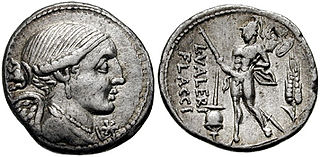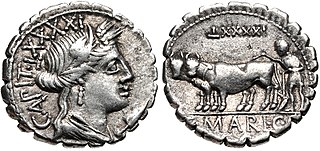Related Research Articles

The gens Petronia was a plebeian family at ancient Rome. This gens claimed an ancient lineage, as a Petronius Sabinus is mentioned in the time of Lucius Tarquinius Superbus, the last of the Roman kings, but few Petronii are mentioned in the time of the Republic. They are frequently encountered under the Empire, holding numerous consulships, and eventually obtaining the Empire itself during the brief reign of Petronius Maximus in AD 455.

The gens Valeria was a patrician family at ancient Rome, prominent from the very beginning of the Republic to the latest period of the Empire. Publius Valerius Poplicola was one of the consuls in 509 BC, the year that saw the overthrow of the Tarquins, and the members of his family were among the most celebrated statesmen and generals at the beginning of the Republic. Over the next ten centuries, few gentes produced as many distinguished men, and at every period the name of Valerius was constantly to be found in the lists of annual magistrates, and held in the highest honour. Several of the emperors claimed descent from the Valerii, whose name they bore as part of their official nomenclature.
Gaius Ummidius Durmius Quadratus was a Roman senator of the Principate. He was the first member of the Ummidii to reach the office of consul in his family, or a homo novus. Quadratus is also known for his tenure as governor of Syria from c. 50 until his death.
Annia Cornificia Faustina was the youngest child and only daughter of the praetor Marcus Annius Verus and Domitia Lucilla. The parents of Cornificia came from wealthy senatorial families who were of consular rank. Her brother was the future Roman emperor Marcus Aurelius, and both were born and raised in Rome.
The gens Aelia, occasionally written Ailia, was a plebeian family in Rome, which flourished from the fifth century BC until at least the third century AD, a period of nearly eight hundred years. The archaic spelling Ailia is found on coins, but must not be confused with Allia, which is a distinct gens. The first member of the family to obtain the consulship was Publius Aelius Paetus in 337 BC.
The gens Arria was a plebeian family at ancient Rome, which occurs in history beginning in the final century of the Republic, and became quite prominent in imperial times. The first of the gens to achieve prominence was Quintus Arrius, praetor in 72 BC.
The gens Caecinia was a plebeian family of Etruscan origin at ancient Rome. Members of this gens are first mentioned in the time of Cicero, and they remained prominent through the first century of the Empire, before fading into obscurity in the time of the Flavian emperors. A family of this name rose to prominence once more at the beginning of the fifth century.
Marcus Ummidius Quadratus Annianus (138–182) was a Roman Senator and the nephew of the Emperor Marcus Aurelius. He was involved in an unsuccessful plot to assassinate his cousin the Emperor Commodus, which led to his execution afterwards.
Ummidia Cornificia Faustina was a wealthy Roman noblewoman, an heiress and the niece of the Roman Emperor Marcus Aurelius.

The gens Maria was a plebeian family of Rome. Its most celebrated member was Gaius Marius, one of the greatest generals of antiquity, and seven times consul.
The gens Ceionia or Caeionia was an ancient Roman family of imperial times. The first member of the gens to obtain the consulship was Lucius Ceionius Commodus in AD 78. The rise of this family culminated in the elevation of the emperor Lucius Verus, born Lucius Ceionius Commodus, in AD 161.

The gens Ulpia was a Roman family that rose to prominence during the first century AD. The gens is best known from the emperor Marcus Ulpius Trajanus, who reigned from AD 98 to 117. The Thirtieth Legion took its name, Ulpia, in his honor. The city of Serdica, modern day Sofia, was renamed as Ulpia Serdica.
The gens Septimia was a minor plebeian family at ancient Rome. The gens first appears in history towards the close of the Republic, and they did not achieve much importance until the latter half of the second century, when Lucius Septimius Severus obtained the imperial dignity.
The gens Cluvia was a plebeian family at ancient Rome, known from the later Republic, and early imperial times. The first member of the gens to achieve prominence was Gaius Cluvius Saxula, praetor in 175 and 173 BC.

The gens Sosia, occasionally written Sossia, was a plebeian family at ancient Rome. Members of this gens occur in history from the end of the Republic down to the third century AD. The first of the Sosii to attain the consulship was Gaius Sosius in 32 BC, and the family would continue holding various positions in the Roman state until the third century.
The gens Pedania was a minor plebeian family at Rome. Members of this gens are first mentioned at the time of the Second Punic War, but they achieved little prominence until imperial times, when the ill-starred Lucius Pedanius Secundus attained the consulship under Nero.
Gaius Ummidius Quadratus Sertorius Severus was a Roman senator active during the second century AD. He was suffect consul in absentia for the nundinium of May to June 118 as the colleague of the emperor Hadrian. He is more frequently known by his shorter name, Gaius Ummidius Quadratus; his full name was known only after a missing piece to an inscription from Tomis was found.

The gens Sentia was a plebeian family at ancient Rome. Members of this gens are first mentioned in history toward the end of the Republic. The first of the Sentii to obtain the consulship was Gaius Sentius Saturninus, in 19 BC.
The gens Statia was a minor plebeian family at ancient Rome. Members of this gens are first mentioned in the early decades of the Republic, but the name does not appear again in history until the time of Cicero. The Statii remained relatively undistinguished until the reign of Trajan, when Lucius Statius Aquila was raised to the consulship.
Gaius Ummidius Quadratus Annianus Verus was a consul suffectus around the year 146 CE.
References
- 1 2 3 4 Dictionary of Greek and Roman Biography and Mythology, vol. III, pp. 631, 632 ("Ummidius Quadratus").
- 1 2 Birley, pp. 43, 44.
- ↑ Horace, Satirae, i. 1. 95.
- 1 2 3 Orelli, Inscriptionum Latinarum, no. 781.
- ↑ Encyclopædia Britannica, Eleventh Edition (1911), s. v. Casinum .
- ↑ Cassell's Latin & English Dictionary, s. v. quadratus, square.
- ↑ Josephus, Antiquitates Judaïcae, xx. 5. § 2, Bellum Judaïcum, ii. 12. §§ 5, 6.
- ↑ Tacitus, Annales, xii. 45 ff, 54, xiii. 8, 9, xiv. 26.
- ↑ Eckhel, vol. iii. p. 280.
- ↑ Orelli, Inscriptionum Latinarum, no. 3665.
- ↑ Pliny the Younger, Epistulae, vii. 24.
- ↑ Pliny the Younger, Epistulae, vi. 11, 29, vii. 24, ix. 13.
- ↑ Aelius Spartianus, "The Life of Hadrian", 15.
- ↑ Syme, "The Ummidii".
- ↑ Syme, "Ummidius Quadratus", p. 292.
- ↑ Julius Capitolinus, "The Life of Marcus Aurelius", 7.
- ↑ Syme, "The Ummidii", pp. 98 ff.
- ↑ John, Drinkwater (2011). A Chronology of the Roman Empire. Continuum International Publishing Group. ISBN 978-144-115-478-1.
- ↑ Shelton, Jo-Ann (2013). The Women of Pliny's Letters. Routledge. ISBN 978-041-537-428-6.
- 1 2 Marcus Aurelius, 1, 8-11.
- ↑ Aelius Lampridius, "The Life of Commodus", 4.
- ↑ Herodian, i. 8.
- ↑ Cassius Dio, lxxii. 4.